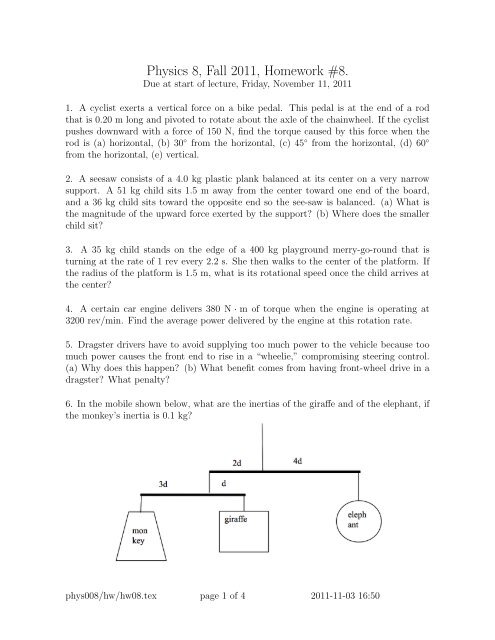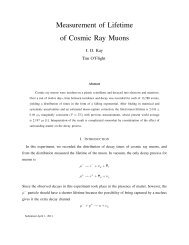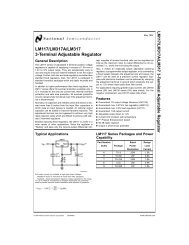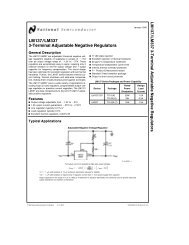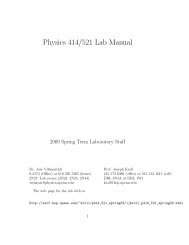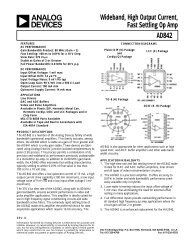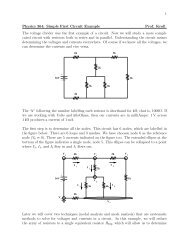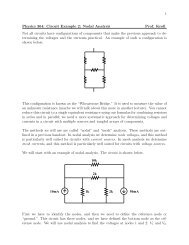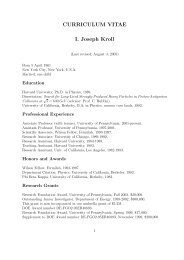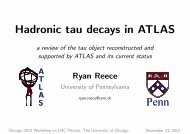Physics 8, Fall 2011, Homework #8.
Physics 8, Fall 2011, Homework #8.
Physics 8, Fall 2011, Homework #8.
Create successful ePaper yourself
Turn your PDF publications into a flip-book with our unique Google optimized e-Paper software.
<strong>Physics</strong> 8, <strong>Fall</strong> <strong>2011</strong>, <strong>Homework</strong> <strong>#8.</strong>Due at start of lecture, Friday, November 11, <strong>2011</strong>1. A cyclist exerts a vertical force on a bike pedal. This pedal is at the end of a rodthat is 0.20 m long and pivoted to rotate about the axle of the chainwheel. If the cyclistpushes downward with a force of 150 N, find the torque caused by this force when therod is (a) horizontal, (b) 30 ◦ from the horizontal, (c) 45 ◦ from the horizontal, (d) 60 ◦from the horizontal, (e) vertical.2. A seesaw consists of a 4.0 kg plastic plank balanced at its center on a very narrowsupport. A 51 kg child sits 1.5 m away from the center toward one end of the board,and a 36 kg child sits toward the opposite end so the see-saw is balanced. (a) What isthe magnitude of the upward force exerted by the support? (b) Where does the smallerchild sit?3. A 35 kg child stands on the edge of a 400 kg playground merry-go-round that isturning at the rate of 1 rev every 2.2 s. She then walks to the center of the platform. Ifthe radius of the platform is 1.5 m, what is its rotational speed once the child arrives atthe center?4. A certain car engine delivers 380 N · m of torque when the engine is operating at3200 rev/min. Find the average power delivered by the engine at this rotation rate.5. Dragster drivers have to avoid supplying too much power to the vehicle because toomuch power causes the front end to rise in a “wheelie,” compromising steering control.(a) Why does this happen? (b) What benefit comes from having front-wheel drive in adragster? What penalty?6. In the mobile shown below, what are the inertias of the giraffe and of the elephant, ifthe monkey’s inertia is 0.1 kg?phys008/hw/hw08.tex page 1 of 4 <strong>2011</strong>-11-03 16:50
7. A 5.0 kg cylinder of radius 0.25 m is free to rotate about an axle through its center. Athread wrapped around the cylinder is pulled straight from the cylinder so as to unwrapwith a steady tension of 20 N. As the thread unwinds, the cylinder rotates, and thereis no slippage between the thread and the cylinder. If the cylinder starts from rest att i = 0 s, find (a) its rotational velocity at t f = 5.0 s and (b) the angle through which ithas turned at t f = 5.0 s. Ignore any friction in the axle.8. A 0.20 kg solid cylinder is released from rest at the top of a ramp 1.0 m long. Thecylinder has a radius of 0.15 m, and the ramp is at an angle of 15 ◦ with the horizontal.What is the rotational kinetic energy of the cylinder when it reaches the bottom of theramp?9. Archimedes’ screw, one of the first mechanical devices for lifting water, consists of avery large screw surrounded by a hollow, tight-fitting shaft (shown below). The bottomend of the device is placed in a pool of water. As the screw is turned, water is carried upalong its ridges and comes out the top of the shaft and into a storage tank. As the handleis turned, work done by the torque exerted on the handle is converted to gravitationalpotential energy of the water-Earth system. Let’s say you want to take a shower usingthis device. You figure your shower will consume 44 liters of water, and so you have toraise this amount to the storage tank 2.5 m above the pool, so it can fall down on you.When you turn the handle, you apply a torque of 12 N · m. How many times must youturn the handle?10. A large steel bar of length l is hinged at one end to a wall. A mechanic holds theother end so that the bar is parallel to the ground and places a penny on the bar right atthe end she is holding. (a) What is the rotational acceleration of the bar when she letsgo? (b) Does the penny remain in contact with the bar after it is released?phys008/hw/hw08.tex page 2 of 4 <strong>2011</strong>-11-03 16:50
11. A light, unstretchable cord is wound around a 47 kg solid cylinder that has a radiusof 0.80 m and is free to rotate about an axle through its long axis. A 15 kg block isconnected to the cord and allowed to slide down a ramp that makes an angle of 50 ◦ withthe horizontal. Find (a) the linear acceleration of the block and (b) the tension in thecord. Ignore friction.12. The top end of a ladder of inertia m rests against a smooth wall, and the bottomend rests on the ground. The coefficient of static friction between the ground and theladder is µ s . What is the minimum angle between the ground and the ladder such thatthe ladder does not slip?13. A 25 kg ladder of length 5.0 m leans against a smooth wall andmakes an angle of 50 ◦ with the ground. A 75 kg man starts to climbthe ladder. If the coefficient of friction between the ground and theladder is µ s = 0.50, what distance along the ladder can he climb beforethe ladder starts to slip?14. A square clock of inertia M = 5.0 kg is hung on a nail drivenin a wall, as shown at right. The length of each side of the squareis l = 20 cm, the thickness is w = 10 cm, and the clock is a distanced = 0.1 cm from the wall at the top, where it hangs on the nail. Assumethat the surface of the wall is very smooth and that the center of massof the clock corresponds to its geometric center. What is the magnitudeof the normal force exerted by the wall on the clock? Make simplifyingapproximations — any answer within 10% of the correct answer getsfull credit.15. You want to hang a 10 kg sign (shown at right) thatadvertises your new business. To do this, you attach a 5.0 kgbeam of length l to a wall at its base by a pivot P . You thenattach a thin cable to the beam and to the wall in sucha way that the cable and beam are perpendicular to eachother. The beam makes an angle of 37 ◦ with the vertical.You hang the sign from the end of the beam to which thecable is attached. (a) What must be the minimum tensilestrength of the cable (the amount of tension it can sustain) ifit is not to snap? (b) Determine the horizontal and verticalcomponents of the force the pivot exerts on the beam.(More on next page!)phys008/hw/hw08.tex page 3 of 4 <strong>2011</strong>-11-03 16:50
16. The top end of a 3.0 m board rests against a smooth wall (as shown below), and thebottom end makes an angle of 37 ◦ with the floor. If the board has an inertia of 4.6 kg,what are (a) the normal force exerted by the floor on the board and (b) the normal forceexerted by the wall on the board?17. A horizontal 2.0 kg rod is 2.0 m long. It has an 8.0 kg block suspended from itsleft end and a 4.0 kg block suspended from its right end. (a) Find the magnitude anddirection of the single extra force necessary to keep the rod in equilibrium. (b) At whatdistance from the left end of the rod must this force be applied?18. A 215 g can of soup is 10.8 cm tall and has a radius of 3.19 cm. (a) Calculate itstheoretical rotational inertia, assuming it to be a solid cylinder. (b) When it is releasedfrom rest at the top of a ramp that is 3.00 m long and makes an angle of 25 ◦ with thehorizontal, it reaches the bottom in 1.40 s. What is the experimental rotational inertia?(c) Compare the experimental and theoretical rotational inertias and suggest possiblesources of the difference.19. A 51 kg box is suspended from the right end of a horizontal rod that has very smallinertia. The left end of the rod is affixed to a wall by a pin. A wire connects the rightend of the rod to the wall directly above the pin, making an angle of 40 ◦ with the rod.(a) Find the tension in the wire. (b) Determine the magnitude of the reaction force thatthe pivot exerts on the rod.phys008/hw/hw08.tex page 4 of 4 <strong>2011</strong>-11-03 16:50


